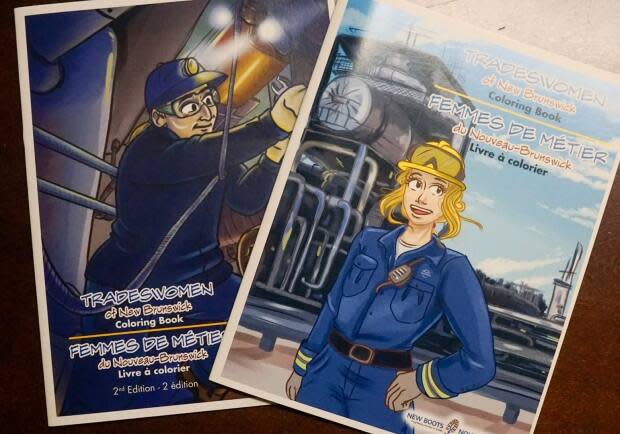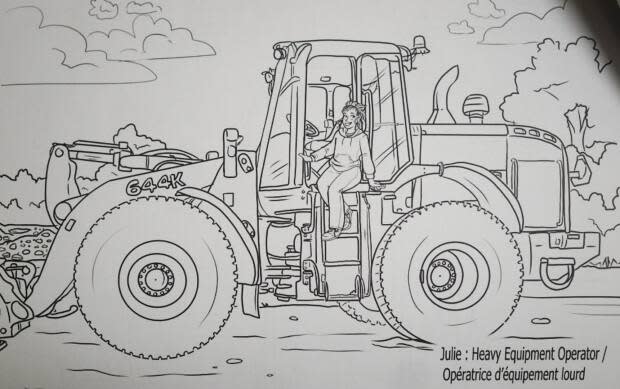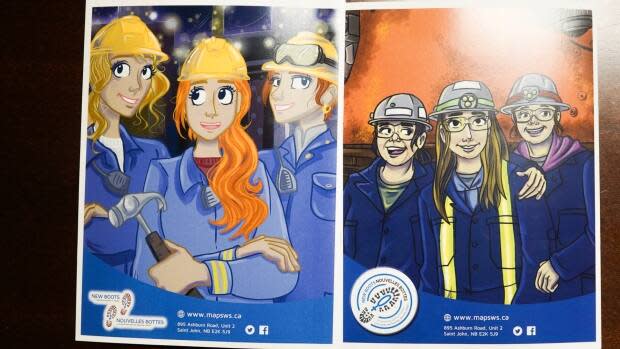The project? Dismantling gender barriers in trades. The strategy? Colouring books for kids

A Saint John non-profit is using a colouring book to spotlight New Brunswick's tradeswomen, while showing kids there's no such thing as a gendered career.
Two editions of the Tradeswomen of New Brunswick colouring books have been published by New Boots: Progressing Women in Trades, a part of the non-profit MAP Strategic Workforce Services.
"I'm super proud of my trade and what I've accomplished," said Liz Sandwith, a refrigeration and air conditioning technician.
"I really think it helps young children, particularly young girls, if they can see themselves represented in skilled trades, it might open a door in their minds to the possibilities they hadn't considered."
Sandwith was featured in the first colouring book, which was published in 2020. A second book appeared in 2021, and a third is now planned in part because so many tradeswomen want to take part.
Sandwith, who now works at New Boots, said the books can also help young boys understand that anyone can do any job.
The artwork in the books was done by Mélanie Blighe, an illustrator from New Brunswick.
The first 500 copies sold out in a week. More copies of both editions are now in stock to help open young minds this holiday season.
The books are aimed at turning around a historically low participation of women in skilled trades. According to the most recently available Statistics Canada data, New Brunswick ranks lowest among the provinces of trade workers who are women. Women make up 4.5 per cent of the trades workforce in New Brunswick, and just seven per cent nationally.

The representation of women in trades has improved significantly in the last 10 years, said Hélène Savoie-Louis, the executive director of MAP Strategic Workforce Services.
But there is still work to be done.
'You didn't see women working in trades'
Sandwith was the first woman to become what is called Red Seal-certified as a refrigeration and air condition tradesperson in New Brunswick, she said. The Red Seal is a federal certification indicating a person has met the national standard in their trade, according to a federal website.
She made the leap from an office job to becoming a trade worker when she was 37. But she said she might have decided much earlier that a trades was the career for her if she'd seen something like the colouring book as a kid.

"You just didn't see it out there. You didn't see women working in trades," she said.
Savoie-Louis said one of the goals of the book is to reach kids when they're starting to learn about traditional gender roles.

"So the goal of the book is that young kids see no gender to a career path, because there isn't a gendered career."
Still work to be done
Savoie-Louis said in the past five years, the number of women in trades in the province increased by one per cent, which she said is significant.
"So still a lot of work to be done. But … we're on our way up," she said.

She said New Boots has done a lot to promote trades to women, but now need to focus on keeping them in the careers.
One issue that women still run into in the field is uncomfortable protective equipment designed for men. Another is a lack of facilities like female washrooms, Savoie-Louis said.
She said it can be difficult for employers to invest in changes because of the cost.
"It's the numbers. Like, 'Why would I bring in a female change room or bathroom when I only have one woman [and] 30 guys?'"
New Boots is trying to fix these issues, by growing the representation of women in the field and educating employers on the issues women face.



